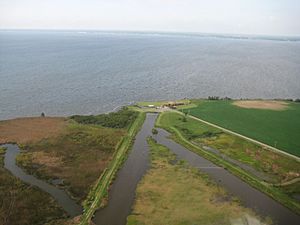Currituck National Wildlife Refuge facts for kids
Quick facts for kids Currituck National Wildlife Refuge |
|
|---|---|
|
IUCN Category IV (Habitat/Species Management Area)
|
|
| Location | Currituck County, North Carolina, United States |
| Nearest city | Knotts Island, North Carolina |
| Area | 8,316 acres (33.65 km2) |
| Established | 1984 |
| Governing body | U.S. Fish and Wildlife Service |
| Website | Currituck National Wildlife Refuge |
The Currituck National Wildlife Refuge is a special place on the northern part of North Carolina's Outer Banks. It was created in 1984 to protect the unique coastal environment of the barrier islands. This refuge helps protect many animals and plants. It's a safe home for waterfowl (like ducks and geese) during winter. It also protects endangered species such as the piping plover bird, sea turtles, and a rare plant called seabeach amaranth.
The refuge has many different types of natural areas, just like other barrier islands. If you start from the Atlantic Ocean and move west towards Currituck Sound, you'll find:
- Sandy beaches
- Grassy sand dunes
- Wet areas between dunes called interdunal wetlands
- Forests and thick bushes that grow near the sea
The edge of Currituck Sound has brackish water marshes. These are wet areas with water that's a mix of fresh and salty. Sometimes, you can also see mudflats when the wind pushes the water away.
There are also a few forested islands in the refuge. One important island is Monkey Island. It's a famous spot where many wading birds build their nests. It's also the northernmost place where the Sabal minor palm tree naturally grows. Besides these palms, you can find many other plants like beach grasses, live oak trees, loblolly pine trees, wax myrtle bushes, and different kinds of cattails, sedges, and rushes.
Many different animals live in the refuge. You can find wading birds, shorebirds, waterfowl, and birds of prey (like eagles and hawks). There are also mammals, including wild horses, and many types of reptiles and amphibians. The endangered piping plover and loggerhead sea turtle sometimes lay their eggs on the refuge's beaches and dunes. The refuge covers a large area of about 8,316 acres (33.65 square kilometers).
Climate and Weather
The Currituck National Wildlife Refuge has a humid subtropical climate. This means it has hot and humid summers, and cool winters. It rains throughout the year.
During summer, a cool sea breeze often blows in the afternoon. However, it can get very hot and humid, sometimes feeling like 100°F (38°C) or more. The refuge is also in an area where hurricanes can happen. The main hurricane season is from June to November, with the most storms usually in late August and September.
In winter, it can get cold and windy. The wind chill can sometimes feel colder than 10°F (-12°C). The average amount of snow in winter is usually less than 2 inches (5 cm). The coldest average temperature in winter is about 14.2°F (-9.9°C).
Ocean Water Temperature
The ocean water temperature near the refuge changes throughout the year:
- Winter (Dec-Feb): Around 44-46°F (6-8°C)
- Spring (Mar-May): Warms up from 46°F to 67°F (8°C to 19°C)
- Summer (Jun-Aug): Warmest, around 71-74°F (22-23°C)
- Fall (Sep-Nov): Cools down from 75°F to 59°F (24°C to 15°C)
Ecology and Plants
The natural plants in the Currituck National Wildlife Refuge are mostly Cordgrass and Coastal Prairie plants. Cordgrass is a type of tough grass that grows in salty marsh areas. Coastal prairies are open, grassy areas found near the coast. These plants are well-suited to the sandy soil and salty air of the barrier island environment.




